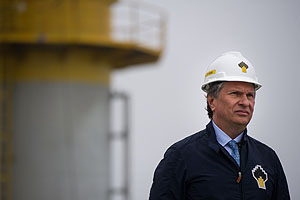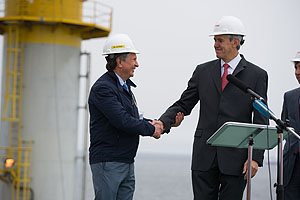Igor Sechin Briefs President Putin on Rosneft Operations in Russian Far East
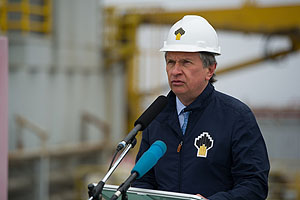
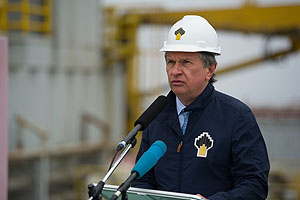 |
Rosneft President and Chairman of the Management Board Igor Sechin reported to Russian President Vladimir Putin on the company operations in the Far East Federal District and mid-term plans to develop offshore projects via a video conference on 16 July. The video link connected Yuzhno-Sakhalinsk, where President Putin was at that time, with the Orlan platform in the Sea of Okhotsk, from which Igor Sechin made his report.
Rosneft is a key production and investment company in the Far East District. In 2013, Rosneft will invest about 52 billion roubles into the Far East development as part of its mainstream activities. These include 27 billion roubles to be invested in exploration and production, 23 billion roubles in refining and upgrading the Komsomolsk Refinery, and about two billion roubles in the petroleum products supply.
“In the next five years, subject to the stabilization of the tariff policy and tax regimes for strategic projects, the Rosneft investment in Eastern Siberia and the Far East could reach more than a trillion roubles under a conservative scenario”, said Rosneft President and Chairman of the Management Board Igor Sechin.
Currently, Rosneft has launched major production and socio-economic projects in the Far East Federal District, including offshore projects, the construction of the Far East Petrochemical Company and an LNG facility, as well as a large-scale modernization of the Komsomolsk Refinery and participation in the Sakhalin-1 project.
Sakhalin-1 as First Offshore Project in the Far East
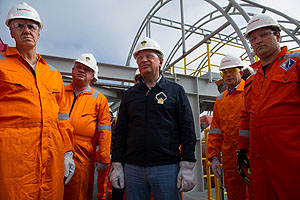 |
Sakhalin-1 is the first offshore project with Russian participation, which came into the production stage. The project was launched in 2001. The overall recoverable reserves of the project’s three fields are totalling 218 million tonnes of oil and 465 billion cubic meters of gas. To date, the cumulative production is 58 million tonnes of oil and 12 billion cubic meters of gas. The Sakhalin-1 project revenues to the state budget have reached about $8 billion.
In 2005, the Orlan platform began production at the Chaivo field. In 2010, the Odoptu field was launched with the unique coastal drilling rig Yastreb. The field has set a world record in the length of a horizontal well: 12.7 kilometres.
Orlan Offshore Drilling Platform
The Orlan offshore drilling platform is located in the Sea of Okhotsk at a distance of 11 kilometres from the coastline. This is a gigantic structure with a unique design and the highest density of equipment per unit area above virtually all other engineering enterprises in this regard. The platform’s weight is about 70,000 tonnes. It is 96 metres long and 89.9 metres wide. The total height of the base is 30 metres. Orlan is able to withstand extremely low temperatures and seismic activity up to 8 points, waves (up to 13 metres high) and ice hummocks (up to 6 metres high). Its total power capacity is 14 megawatts; the capacity of its heavy rig is up to 750 tonnes with a drive of 2,300 horsepower. It allows the platform to achieve the top production of 23,000 tonnes a day via 20 wells. Each well can deviate up to 13 kilometres along the horizon. Until recently, such wells could be drilled onshore only. Now, this technology is available on Orlan. It is the world’s first platform of this kind.
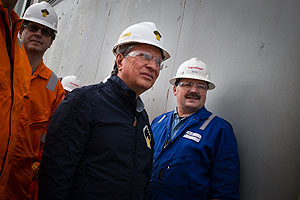 |
The platform’s base was designed and built by Russian professionals. The platform was built in Japan, but has been refitted in Russia and changed over from exploration to production. The change-over project was carried out at the Amur Shipyard with the design, construction and engineering support by Rubin Central Design Bureau for Marine Engineering and the N.P. Melnikov Central Scientific Research and Design Institute of Steel Building Structures.
Another platform is being constructed in the Okhotsk Sea some 10 kilometres from Orlan. Its reinforced concrete base was also built in Russia in the city of Nakhodka and installed in 2012. Such facilities will also be used in joint offshore projects of Rosneft and ExxonMobil.
Rosneft Offshore Projects in the Far East
The Far East offshore blocks along the offshore fields in the northern and southern seas are the new hydrocarbon base of Russia. The development of offshore fields requires lots of marine technology and machinery: about 400 drilling platforms, ice-breakers, auxiliary vessels and supply vessels, gas carriers and tankers. That is, in addition to the development of a new source of hydrocarbons, a multi-billion demand for high-tech products in the neighbouring segments is emerging: mechanical engineering, shipbuilding, metallurgy, transport, oilfield equipment manufacturing. Offshore projects allow Russia to create a powerful shipbuilding cluster capable of responding to the needs of the oil and gas sector and independently build lots of the Arctic Class platforms and vessels. In addition, such large-scale projects enable regions to develop their infrastructure while stimulating the construction of ports, power facilities, motor roads and railways, as well as the establishment of related productions with dozens of thousands of new jobs.
Rosneft has licenses for 20 offshore blocks on the Arctic and Far Eastern continental shelf: three in the Chukchi Sea, three in the Laptev Sea, and 14 in the Sea of Okhotsk. A large-scale exploration programme is being implemented in these fields. Two seismic exploration vessels of Dalmorneftegeofizika are exploring the Magadan offshore areas as part of the Magadan-1, Magadan-2 and Magadan-3 projects. Exploration is underway on the Sakhalin shelf in the Astrakhanovskoe Sea – Nekrasovsky license field. The resource potential of the fields is 14 billion tonnes of oil equivalent.
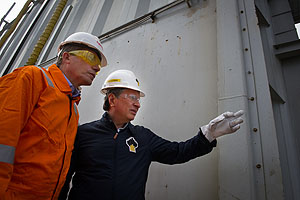 |
During the implementation of the Sakhalin projects, Rosneft is going to attract regional manufacturing and engineering organization and use local raw materials and human resources wherever it is possible. Rosneft will promote the development of infrastructure in the Sakhalin Region and create new jobs. These ideas were emphasized at the meeting of Igor Sechin and Sakhalin Governor Alexander Khoroshavin, which also took place during the working trip of the Rosneft head to the Far East.
The parties have signed a Supplement to the Cooperation Agreement, which, in particular, includes the idea to construct an LNG plant and gas pipeline infrastructure in the Sakhalin region. It is assumed that the area next to the towns of Ilyinskoe and Taranay will be the construction ground for the LNG facility. Ensuring environmental safety is a prerequisite of the project.
The agreements reached can significantly expand the current cooperation of Rosneft and the Government of the Sakhalin region. The Cooperation Agreement envisages the creation of an enabling environment for geological studies of the island’s subsoil, improving exploration effectiveness, enhancing oil and gas exploration and the oil recovery factor, as well as introducing innovation and establishing information resources in this area. The supply of aviation fuel to the Sakhalin region airports and expansion of the Rosneft filling station chain are also top-priority issues of the cooperation plan.
Possible Deployment of LNG Plant on Sakhalin
The growth of Rosneft’s resource base in Eastern Siberia and the Far East provides an opportunity to launch new strategic projects. Currently, Rosneft together with ExxonMobil and support of the Sakhalin Region Government is developing an LNG facility project. The stakeholders are discussing where to build the plant, assessing the ice and storm loads, logistics, prospect markets, and the effectiveness of the project.
In June 2013, Rosneft entered into agreements with Marubeni Corporation, SODECO and Vitol SA on the basic terms of the LNG purchase and sale. These companies will secure a stable market for the Rosneft LNG plant. In accordance with the signed agreements, Rosneft plans to start long-term supply of LNG in 2019: 1.25 million tonnes a year for Marubeni, 1 million tonnes a year for Sodeco, and 2.75 million tonnes year for Vitol.
Far East Petrochemical Company Construction Project
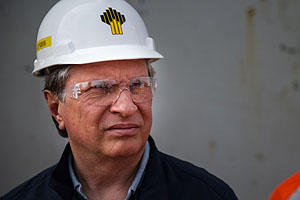 |
Given the growing needs of the Far East regions, the creation of the Far East Petrochemical Company with a capacity of up to 30 million tonnes in the Primorsky Territory running on its own resource base will eliminate the risks of petroleum products shortage and secure the development of the regions’ infrastructure: the construction of ports, power facilities, motor roads and railways, as well as the establishment of related productions with dozens of thousands of new jobs.
The Komsomolsk Refinery is a key source of petroleum products in the Far East and a prospective supplier to markets in Asia Pacific. Currently, the refinery can process 8 million tonnes of raw materials.
The Refinery’s large-scale modernization programme is comparable with the construction of a new refinery. The programme includes the construction of new hydrocracking units, reformers and coking units, plus 25 other facilities. Part of the project has already been carried out: the delayed coking unit was built in 2011, the catalytic reformer was reconstructed in 2012. The construction of the hydrocracking units with the capacity of 2 million tonnes a year (to be commissioned in December 2015) will increase refining depth to 95%.
|
|
Rosneft
Information Division,
July 22, 2013
